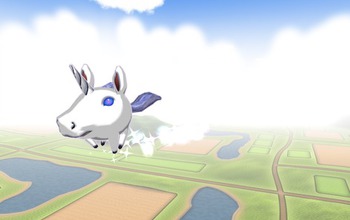All Images
Research News
Tech Sandbox: The playground of neural engineering

Electrical signals from smiles help a unicorn fly, collect rainbow magic and save the world from impending darkness in the game, "Unicorb." The unicorn is controlled by muscle activity from positive facial expressions (recorded using facial EMG), including smiling and eyebrow-raising.
"Unicorb" was designed by students participating in the 2014 Tech Sandbox competition held by the NSF Engineering Research Center for Sensorimotor Neural Engineering, which investigates new technologies to help people who are paralyzed or disabled. Sparklight Studios of Seattle assisted in game development.
Credit: Tiffany M. Youngquist, Center for Sensorimotor Neural Engineering, University of Washington
Download the high-resolution PNG version of the image. (950.7 KB)
Use your mouse to right-click (Mac users may need to Ctrl-click) the link above and choose the option that will save the file or target to your computer.

James Wu, Tiffany Youngquist, Tyler Maxfield and Karl Marrett (pictured left to right) of the University of Washington created the game "Unicorb" for the 2014 Tech Sandbox competition.
The game is controlled by electrical signals generated by smiling, which are picked up by non-invasive electrodes. Brain-computer interfaces with non-invasive electrodes are one research area for the NSF Engineering Research Center for Sensorimotor Neural Engineering, which pursues new technologies to help people who are paralyzed or disabled and holds the Tech Sandbox competition each year.
Credit: Eric H. Chudler, Center for Sensorimotor Neural Engineering
Download the high-resolution JPG version of the image. (39.8 KB)
Use your mouse to right-click (Mac users may need to Ctrl-click) the link above and choose the option that will save the file or target to your computer.

James Wu describes Team Thalia's project and "Unicorb" in a YouTube video titled "UW Tech Sandbox -Team Thalia" that shows Wu playing Unicorb at the Tech Sandbox competition on March 13, 2014, with fellow team members Tiffany Youngquist speaking and Tyler Maxfield in the background.
Tech Sandbox students get access to research equipment at the NSF Engineering Research Center for Sensorimotor Neural Engineering, which investigates new technologies to help people who are paralyzed or disabled.
Credit: Adiba Khan, University of Washington
Download the high-resolution JPG version of the image. (38.9 KB)
Use your mouse to right-click (Mac users may need to Ctrl-click) the link above and choose the option that will save the file or target to your computer.

WrestleBrainia 3000 won the 2013 Tech Sandbox student competition held by the NSF Engineering Research Center for Sensorimotor Neural Engineering, which investigates new technologies to help people who are paralyzed or disabled. The two-player game uses electrical signals from players' muscles to power an arm-wrestling match between them.
Players get visual feedback about their muscle-firing patterns and learn basic concepts about the nervous system. WrestleBrainia 3000 was also demonstrated at the 2014 International Consumer Electronics Show and at the 2014 USA Science and Engineering Festival.
Credit: Eric H. Chudler, Center for Sensorimotor Neural Engineering
Download the high-resolution JPG version of the image. (851.8 KB)
Use your mouse to right-click (Mac users may need to Ctrl-click) the link above and choose the option that will save the file or target to your computer.


